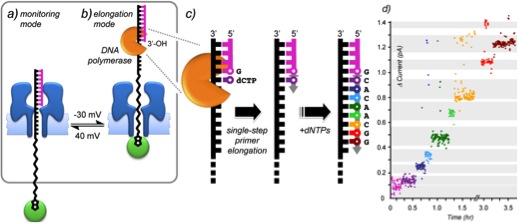|
|||||||||||
|---|---|---|---|---|---|---|---|---|---|---|---|
Protein nanopore-based DNA sequencing
Ultrarapid DNA sequencing would allow physicians to acquire full on-the-spot genomic information and would therefore advance clinical practice to provide a level of care that would have been unbelievable just a few years ago. We are working to advance several critical limitations associated with ultrarapid DNA sequencing. Our approach involves nanopore strand sequencing, in which a single strand of DNA moves through a narrow pore, the alpha-hemolysin (aHL) protein nanopore, and the bases are identified as they pass a reading head. We are investigating methods to control and monitor the translocation of single stranded DNA through a nanopore with single-nucleotide resolution. We have recently made a breakthrough in this field by designing the first supramolecular nanopore device capable of detecting up to nine consecutive DNA polymerase-catalyzed single nucleotide primer extensions with high sensitivity and spatial resolution (2.4 Å). In this setup, the polymerase acts as a molecular motor to pull the DNA through the pore, base-by-base, at a controllable rate. Single nucleotide primer extensions resulted in successive displacements of the template DNA strand within the protein pore, which was monitored by the corresponding step changes in the ion current flowing through the pore under an applied potential. Another major challenge in developing robust, convenient, and practical device that functions with an embedded protein nanopore (i.e. alpha-hemolysin) is the low stability of bilayer lipid membranes. To address this challenge, we have engineered novel polymerizable lipids to improve the robustness of lipid bilayers in the context of nanopore sequencing. We are following several innovative approaches to the design of polymerizable lipid membranes.
|
|||||||||||
| Copyright 2019 © Ghadiri Laboratory, The Scripps Research Institute |

